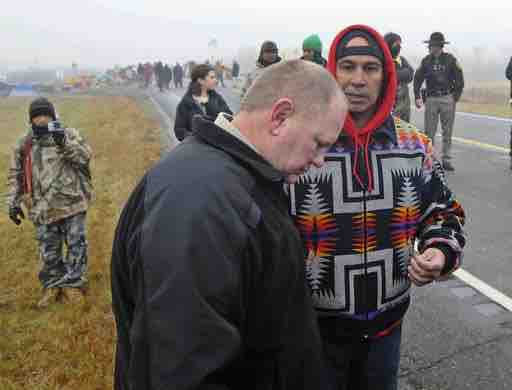Dakota Access Pipeline Protesters Told to Leave by Dec. 5

BISMARCK, N.D. (AP) — The U.S. Army Corps of Engineers has set an early December deadline for American Indians and others to leave an encampment in North Dakota where they’ve been entrenched for months protesting the Dakota Access pipeline. Tribes including the Standing Rock and Cheyenne River Sioux are fighting the Dakota Access project because they fear it will harm drinking water and cultural sites. Texas-based pipeline developer Energy Transfer Partners says the 1,200-mile pipeline through the Dakotas, Iowa and Illinois will be safe.
The Corps said last week in a letter to Standing Rock Sioux tribal leader Dave Archambault that all federal lands north of the Cannonball River will be closed to public access Dec. 5 for “safety concerns.” The order includes the sprawling encampment called Oceti Sakowin, or Seven Council Fires camp, that’s a living protest against the four-state $3.8 billion pipeline.
The Corps cited North Dakota’s oncoming winter and increasingly contentious clashes between protesters and police. The agency says “it has no plans for forcible removal,” but anyone on land north of the river after the deadline will be trespassing and may be prosecuted.
The Corps said “more dangerous groups have joined this protest and are provoking conflict in spite of the public pleas from tribal leaders.”
The agency previously had said it would not evict protesters due to free speech reasons.
The Corps’ letter came after residents in the area expressed feeling unsafe and frustrated with how the protest has swelled to scores of self-described “water protectors.” North Dakota officials contend that the Corps should not allow people to be on the land without a permit.
More than 525 people from throughout the country have been arrested since August. In a recent clash between police and protesters near the path of the pipeline, officers used tear gas, rubber bullets and large water hoses in freezing weather. Organizers said at least 17 protesters were taken to the hospital, some for hypothermia and one for a serious arm injury. One officer was injured.
North Dakota officials say the protest has cost the state about $20 million in extra law enforcement costs.
Related News
Related News

- Keystone Oil Pipeline Resumes Operations After Temporary Shutdown
- Biden Administration Buys Oil for Emergency Reserve Above Target Price
- Freeport LNG Plant Runs Near Zero Consumption for Fifth Day
- Enbridge to Invest $500 Million in Pipeline Assets, Including Expansion of 850-Mile Gray Oak Pipeline
- Williams Delays Louisiana Pipeline Project Amid Dispute with Competitor Energy Transfer
- Evacuation Technologies to Reduce Methane Releases During Pigging
- Editor’s Notebook: Nord Stream’s $20 Billion Question
- Enbridge Receives Approval to Begin Service on Louisiana Venice Gas Pipeline Project
- Russian LNG Unfazed By U.S. Sanctions
- Biden Administration Buys Oil for Emergency Reserve Above Target Price




Comments